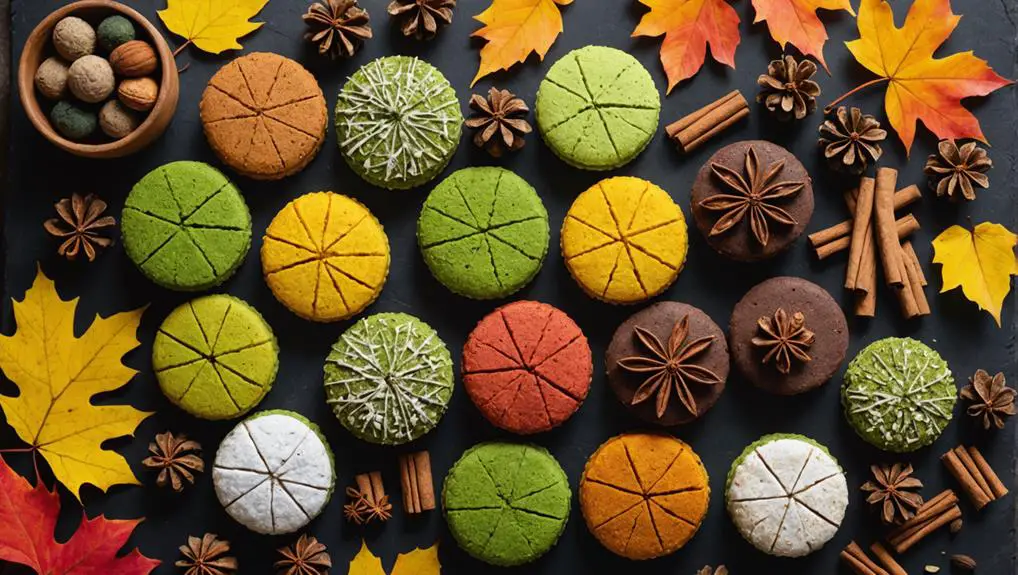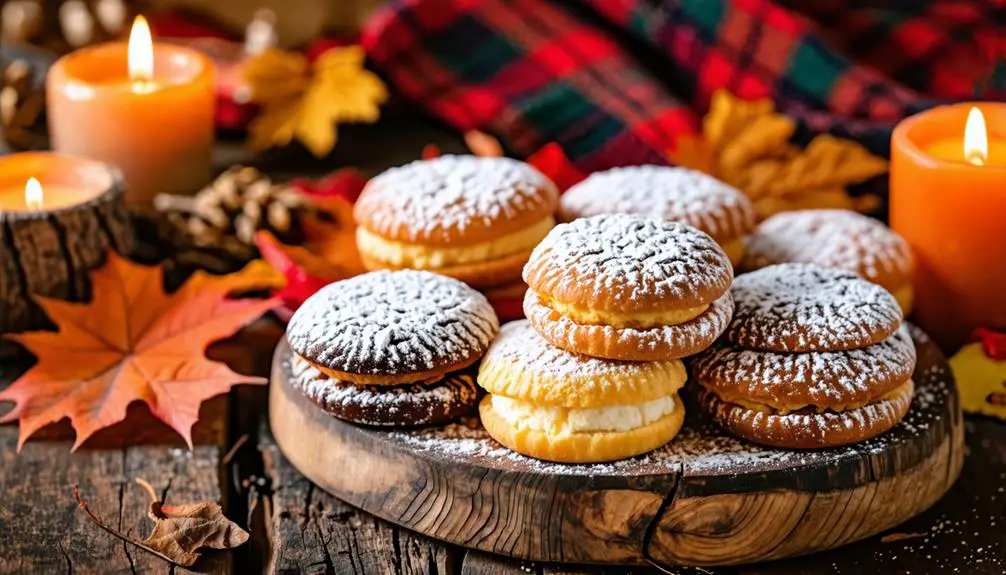In many Spanish households, the aroma of freshly baked polvorones fills the air as families prepare to celebrate the autumn season. These sweet, crumbly cookies, crafted from toasted flour and ground almonds, embody a rich culinary tradition that dates back centuries. Their melt-in-your-mouth texture and delicate dusting of powdered sugar often evoke feelings of nostalgia and togetherness. However, the significance of polvorones extends beyond their taste; they hold a unique place in Spanish culture that invites exploration of their origins, variations, and the cherished rituals surrounding them.
Need cookware for your meal? Toolbox, a Pear to Pear rental marketplace, might be worth a look.
Quick Takeaways
- Polvorones are traditional Spanish cookies, known for their soft, crumbly texture and rich flavors, perfect for festive autumn celebrations.
- Made primarily from toasted flour, ground almonds, and lard, they hold a unique place in Spanish culinary heritage.
- These cookies symbolize warmth and hospitality, often shared during family gatherings and festive occasions in Spain.
- Flavor variations include chocolate, citrus, and spices, allowing for creative adaptations while maintaining the original texture.
- Polvorones are enjoyed year-round, serving as delightful reminders of togetherness and the joy of sharing with loved ones.
Overview of Polvorones
Savoring polvorones transports one to the festive spirit of Spain, where these traditional Christmas cookies have delighted taste buds for centuries. With their soft, crumbly texture, polvorones embody the essence of Spanish cuisine, reflecting a rich history that dates back to the 16th century.
Their name, derived from "polvo," meaning "dust," speaks to the delicate consistency that makes them irresistible. Crafted primarily from toasted flour, ground almonds, and pork lard, these cookies offer a unique blend of flavors and textures that melt in the mouth.
Families often make them during the Christmas season, sharing the treats as symbols of warmth and hospitality. Variations abound, with some bakers adding hints of cinnamon or chocolate for a twist on the classic recipe.
Before serving, polvorones are typically dusted with powdered sugar, enhancing their festive appeal and making them a delightful addition to any holiday gathering.
Whether enjoyed at family reunions or festive parties, these cookies remind everyone of the joy of sharing, bringing friends and loved ones together around the table to savor the sweet flavors of tradition.
Key Ingredients and Preparation
The creation of polvorones hinges on a few key ingredients that work together to form their signature taste and texture. Traditional recipes call for 1¼ cups of all-purpose flour, ½ cup of almond flour, and 1 cup of softened lard or butter, which lend a rich flavor and guarantee a delicate texture.
Alongside these, 1½ cups of icing sugar and ½ cup of lightly toasted, chopped almonds add sweetness and depth, making these festive cookies a delight during Christmas time.
Preparation begins by sifting and toasting the flours at a low temperature of 250°F for about 30 minutes, achieving a light brown hue that enhances their taste. Once the ingredients form a dough, it's shaped into round disks and dusted with powdered sugar prior to baking.
The dough should refrigerate for 2 hours, helping it maintain its shape. Baking occurs at a preheated temperature of 480°F, then reduced to 350°F for 10-15 minutes.
After baking, handling the cookies gently is essential to prevent crumbling, as polvorones are renowned for their melt-in-your-mouth quality, making them an elegant treat to serve at any festive gathering.
Baking Techniques and Tips
Achieving the perfect polvorón requires careful attention to detail throughout the baking process. One of the essential baking techniques involves toasting the flour at a low temperature (around 250°F) for about 30 minutes. This step enhances the nutty flavor and contributes to that coveted crumbly texture.
After toasting, it's vital to chill the dough for at least 20 minutes before shaping; this helps maintain the cookies' form and prevents excessive spreading during baking.
When it's time to bake, remember to preheat the oven to 350°F. Place the cookies inside and bake them for 10-15 minutes until the edges turn a lovely golden brown. Be cautious not to overbake, as this will compromise their delicate, fragile texture.
Once baked, gently handle the cookies, allowing them to cool completely on a wire rack to avoid crumbling.
For a festive flair, roll the warm cookies in a delightful mixture of powdered sugar and ground cinnamon right after they come out of the oven. This not only enhances their flavor but also elevates their presentation, making them a perfect treat to serve during autumn celebrations.
Cultural Significance and Traditions
Polvorones embody the spirit of Spanish Christmas celebrations, representing warmth, hospitality, and the joy of sharing with loved ones. These delightful cookies, made primarily from almond flour and lard, boast a crumbly texture that melts in the mouth, aptly reflecting their name, which derives from "polvo," meaning "dust."
During festive gatherings, families enthusiastically prepare and share polvorones, reinforcing traditions that span generations. Their cultural significance is profound, as they symbolize not just the holiday spirit but also the rich history of Spain's culinary evolution, influenced by Arab cuisine.
Each region boasts its variations, sparking friendly debates over the true birthplace of these beloved treats, particularly between Estepa and Antequera.
While polvorones shine brightest during Spanish Christmas, their appeal stretches throughout the year, making them a cherished treat for various occasions. They serve as a reminder of the importance of togetherness and the joy of serving others, whether presented on a holiday table or gifted to friends.
In every crumbly bite, one can taste the love and tradition that binds families, making polvorones an integral part of Spain's festive landscape.
Flavor Variations and Adaptations

Celebrating the rich traditions of polvorones naturally leads to exploring the diverse flavor variations and adaptations that have emerged over time. These delightful festive treats can be tailored to suit any palate, showcasing the versatility of the classic recipe.
For instance, chocolate polvorones, made with cocoa powder, offer a decadent twist, while invigorating citrus variations, featuring lemon or orange peels, bring a bright, zesty flavor.
Traditional recipes often incorporate a variety of spices like cinnamon, nutmeg, and cardamom, enhancing the cookies' aromatic profile. Regional adaptations also shine, with unique nut additions such as hazelnuts or pecans that provide different textures and tastes.
For those seeking gluten-free options, substituting regular flours with almond flour or other alternatives allows more people to indulge in these crumbly delights.
Additionally, bakers frequently experiment with extracts like almond or vanilla, enriching the polvorones' flavor while preserving their beloved texture. These innovations guarantee that each batch of polvorones resonates with personal touches, making them perfect for sharing during autumn celebrations and beyond.
Common Questions
What Do Polvorones Mean in English?
Polvorones, translated as "dust cookies" in English, aptly describes their delicate, crumbly texture. The term comes from the Spanish word "polvo," meaning "dust."
These cookies are rich in flavor, often featuring ingredients like pork lard and ground almonds. While they hold a special place in Spanish festive traditions, their delightful taste resonates with many, making them a beloved treat worldwide.
They're perfect for sharing and creating cherished memories with loved ones.
What Is the Number 1 Christmas Cookie?
In Spain, the number one Christmas cookie is unquestionably the polvorón. This delightful treat, known for its soft, crumbly texture, melts in your mouth, enchanting everyone who tries it.
Made with toasted flour, ground almonds, and a hint of cinnamon, it embodies the warmth of holiday gatherings. Traditionally shared among families or given as gifts, these cookies symbolize Spanish hospitality, making them a cherished staple during festive celebrations throughout the country.
What Is the History of Polvorón Cookies?
In a cozy kitchen, the aroma of baking cookies wafts through the air, reminiscent of generations past.
Polvorones, originating from Andalusia, Spain, date back to the 16th century, showcasing a blend of local and Moorish influences. Their name, derived from "polvo," reflects their delicate texture.
While early recipes avoided pork lard, later adaptations embraced it.
Today, these crumbly treats symbolize warmth and togetherness, gracing festive tables and family gatherings during the holiday season.
What Is the Difference Between Polvorones and Mantecados?
When comparing polvorones and mantecados, one notices distinct characteristics.
Polvorones are oval-shaped and often dusted with powdered sugar, while mantecados are round and made with pork lard, offering a different texture.
The dough base is similar, yet polvorones emphasize toasted flour and almond flavors, whereas mantecados come in various flavors like cocoa and lemon.
Additionally, polvorones are festive treats enjoyed mainly during Christmas, while mantecados are savored throughout the year.
Wrapping Up
In every crumbly bite of polvorones, one can taste the essence of Spanish autumn—like the warm embrace of a grandmother's hug during family gatherings. These cookies aren't just treats; they're a bridge between generations, uniting loved ones in laughter and shared stories. Whether dusted in powdered sugar or infused with unique flavors, polvorones embody the spirit of celebration, reminding everyone that joy is best savored together, one sweet morsel at a time.
